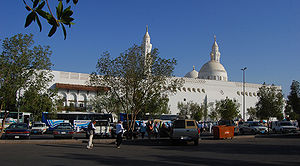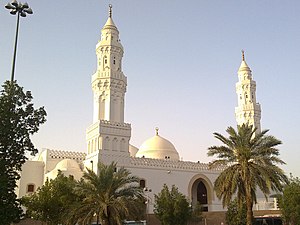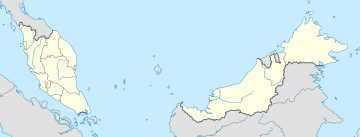From Wikipedia, the free encyclopedia
Kota Bharu is a
city in
Malaysia, is the state capital and Royal City of
Kelantan. It is also the name of the territory (jajahan) in which Kota Bharu City is situated. The name means 'new city' or 'new castle/fort' in Malay. Kota Bharu is situated in the northeastern part of
Peninsular Malaysia, and lies near the mouth of the
Kelantan River at
 6°8′N 102°15′E
6°8′N 102°15′E. In
2005, it had an estimated population of 425,294, making it one of the largest towns on the east coast of Peninsular Malaysia. By 2009, it became by far the most populous town on the east coast of Peninsular Malaysia with an estimated population of 577,301 and continues to increase to the estimated population of 609,886 in 2010 thus make it the most dense town on the east coast of Peninsular Malaysia. Kota Bharu is at rank of 10th in the list of the
largest cities in Malaysia.
This northeastern Malaysian city is close to the
Thai border, and is home to many
mosques. Also of interest are various museums and the unique architecture of the old royal palace (still occupied by the
sultan and
sultanah and off-limits to visitors but viewable from outside) and former royal buildings (which can be visited) in the center of town.
[edit]Climate
Kota Bharu features a
tropical rainforest climate. Kota Bharu does not have a true
dry season as all 12 months sees on average more than 60 mm of precipitation. However, Kota Bharu experiences noticeably heavier rainfall from August through January. Also, in comparison to the rest of the year, Kota Bharu experiences slightly cooler temperatures between December and February, than it does during the rest of the year. The city sees on average about 2700 mm of precipitation annually.
| [hide]Climate data for Kota Bharu |
|---|
| Month | Jan | Feb | Mar | Apr | May | Jun | Jul | Aug | Sep | Oct | Nov | Dec | Year |
|---|
| Average high °C (°F) | 28.9
(84) | 29.4
(85) | 30.6
(87) | 32.2
(90) | 32.2
(90) | 32.2
(90) | 31.7
(89) | 31.7
(89) | 31.7
(89) | 30.6
(87) | 28.9
(84) | 28.3
(83) | 30.6
(87) |
|---|
| Average low °C (°F) | 22.8
(73) | 22.8
(73) | 23.3
(74) | 23.9
(75) | 23.9
(75) | 23.3
(74) | 23.3
(74) | 23.3
(74) | 23.3
(74) | 23.3
(74) | 23.3
(74) | 22.8
(73) | 23.3
(74) |
|---|
| Precipitation mm (inches) | 120
(4.72) | 80
(3.15) | 90
(3.54) | 100
(3.94) | 90
(3.54) | 140
(5.51) | 130
(5.12) | 210
(8.27) | 180
(7.09) | 280
(11.02) | 570
(22.44) | 650
(25.59) | 2,700
(106.3) |
|---|
| Source: http://www.weatherbase.com/weather/weather.php3?s=51684&refer=&units=metric |
[edit]History
Kota Bharu was established by Sultan
Muhammad II of Kelantan in 1844 as Kelantan's capital.
[1] Before that, Kelantan capital was at Kota Kubang Labu. Kota Bharu also known as Kuala Kelantan before 1844.
Pantai Sabak, about 10 km from Kota Bharu, was the initial landing point of the
Japanese invasion forces on 8 December 1941 in their Malayan campaign when they successfully engaged the British in jungle warfare
[2] and ultimately captured
Singapore[edit]Federal Parliament and State Assembly Seats
List of Kota Bharu district representatives in the Federal Parliament (Dewan Rakyat)
| Parliament | Seat Name | Member of Parliament | Party |
|---|
| P20 | Pengkalan Chepa | Abdul Halim Abdul Rahman | Pakatan Rakyat (PR) |
|---|
| P21 | Kota Bharu | Wan Abdul Rahim Wan Abdullah | Pakatan Rakyat (PR) |
|---|
| P24 | Kubang Kerian | Salahuddin Ayub | Pakatan Rakyat (PR) |
|---|
| P26 | Ketereh | Abdul Aziz Abdul Kadir | Pakatan Rakyat (PR) |
|---|
| Parliament | State | Seat Name | State Assemblyman | Party |
|---|
| P20 | N5 | Kijang | Wan Ubaidah Omar | Pakatan Rakyat (PR) |
|---|
| P20 | N6 | Chempaka | Nik Abdul Aziz Nik Mat | Pakatan Rakyat (PR) |
|---|
| P20 | N7 | Panchor | Mohd Amar Abdullah | Pakatan Rakyat (PR) |
|---|
| P21 | N8 | Tanjong Mas | Rohaini Ibrahim | Pakatan Rakyat (PR) |
|---|
| P21 | N9 | Kota Lama | Tan Teng Loon @ Anuar Tan Abdullah | Pakatan Rakyat (PR) |
|---|
| P21 | N10 | Bunut Payong | Takiyuddin Hassan | Pakatan Rakyat (PR) |
|---|
| P24 | N17 | Salor | Husam Musa | Pakatan Rakyat (PR) |
|---|
| P24 | N18 | Pasir Tumboh | Ahmad Baihaki Atiqullah | Pakatan Rakyat (PR) |
|---|
| P24 | N19 | Demit | Muhammad Mustafa | Pakatan Rakyat (PR) |
|---|
| P26 | N23 | Melor | Wan Ismail Wan Jusoh | Pakatan Rakyat (PR) |
|---|
| P26 | N24 | Kadok | Azami Mohd Nor | Pakatan Rakyat (PR) |
|---|
| P26 | N25 | | Barisan Nasional (BN) |
|---|
[edit]Demographics
The city population has a overwhelming majority Malay population. The Chinese minorities are more prominent in Kota Bharu compared to other parts of Kelantan due to the fact that the Chinese usually reside in urban areas. Ranking Population Kota Bharu
District (Jajahan)
| Rank | Sub-districts (Mukim) | Population 2000 |
|---|
| 1 | Panji | 59,291 |
| 2 | Kubang Kerian | 48,714 |
| 3 | Kota Bharu | 47,790 |
| 4 | Ketereh | 34,430 |
| 5 | Kemumin(P.C) | 32,484 |
| 6 | Badang | 30,237 |
| 7 | Kota | 21,824 |
| 8 | Peringat | 20,721 |
| 9 | Sering | 19,098 |
| 10 | Banggu | 17,739 |
| 11 | Kadok | 17,064 |
| 12 | Pendek | 15,570 |
| 13 | Limbat | 14,778 |
| 14 | Salor | 9,790 |
| 15 | Dewan Beta | 9,305 |
[edit]Religion
Kota Bharu's population is 70% muslim. With the remainder consisting of Buddhists and Christians. The Indigenous peoples which reside in the outskirts are generally practising christians. The local Chinese community which are mainly urban practise mainly Buddhism. The local state government is helmed by the
Pan-Malaysian Islamic party, hence it has pursued a stricter form of Islam in the city and state, Kota Bharu was declared an Islamic City vis-a-vis
Kota Bharu Bandaraya Islam. Morality police are ubiquitous here and apprehend people who engaged in acts perceived immoral. Kota Bharu is the most conservative city in Malaysia. The
Jawi script is applied in streetnames and restaurants.
Social activities that do not contradict with the Islamic norm are allowed. Government offices and many stores are closed on Fridays and Saturdays, but the vibrant markets remain open except for Islamic prayer times. The conservative Kelantanese state government under
PAShas implemented some Islamic laws. These include switching on lights in cinemas during screening time until cinemas were closed down. and separate check-out counters in supermarkets for males and females and
khalwat, the Islamic rule on proximity between males and females. However, these regulations only apply for Muslims only.
The Kota Bharu Municipal Council, the local government authority, discourage the wearing of
indecent attire by female employees in retail outlets and restaurants.
[3] Those who are caught for
dressing indecently may be fined up to
RM 500. The definition of
indecent dressinginclude "body hugging outfits which show off the body, blouses which show the
navel, see through blouses, mini-skirts and tight pants.
[3][edit]Culture
The Kelantanese culture is a smorgasbord of Malay and Thai influences due to its geographical proximity with Thailand. The Chinese here are much more assimilated with local culture compared with other parts of Malaysia. Much of the food are spicy with rice as the primary staple as the local diet. Traditional dances like
Mak Yong and
Wayang Kulit were widely practised here but the practise was clamped down by the local authorities due to perceived Hindu Influences which is thought to contradict Islam.
[edit]Shopping
The more famous shopping destination in Kota Bharu is
Pasar Siti Khadijah (Kota Bharu Central Market), where many goods are sold. Most of the sellers are women. Next to Central Market is the nearly completed construction of Kota Bharu Trade Center (KBTC) which is considered one of the largest mall in Kota Bharu and has opened in August 2009.
Parkson is the anchor tenant for this shopping mall. These two buildings are connected by an overpass on the second floor. Other shopping centers in Kota Bharu are
KB Mall, Pelangi Mall, Kota Seri Mutiara, Pantai Timur, The Store and the new Nirwana Maju (at Bandar Baru Kubang Kerian). A new Tesco hypermarket has opened in 2008. Most of Kota Bharu's downtown shopping area is currently undergoing a major reconstruction and several multi-story shopping centers are in their early construction phases in this vicinity. By March 2010, a new Mydin Mall has been opened and located at Bandar Baru Kubang Kerian on the east. Other shopping complex will open soon is Mydin Mall, is located at Bandar Baru Tunjong on south of Kota Bharu. Giant Hypermarket also take place to be open in Bandar Baru Tunjong.
[edit]Beaches
All major beaches in the Kota Bharu vicinity are currently prone to excessive erosion by strong surf. The community has been implementing wave breakers and tries to protect the shoreline by piling up massive amounts of boulders. Regular beach activity has become impossible as visitors frequent beaches further south. The famous beach in kota bharu as tourist attraction is Pantai Cahaya bulan.
[edit]Wreck Diving
Diving in Kota Bharu is a relatively new activity, with only one dive operator currently offering trips out to the
Japanese Invasion Wreck (
IJN Awazisan Maru). This Japanese transport ship was the very first vessel to sink in The
Pacific War. There is a vast variety of marine life around the ship, most notably the giant barracudas that circle around. The wreck is only a 30 minute boat journey from the jetty, which is 10 minutes outside of Kota Bharu.








